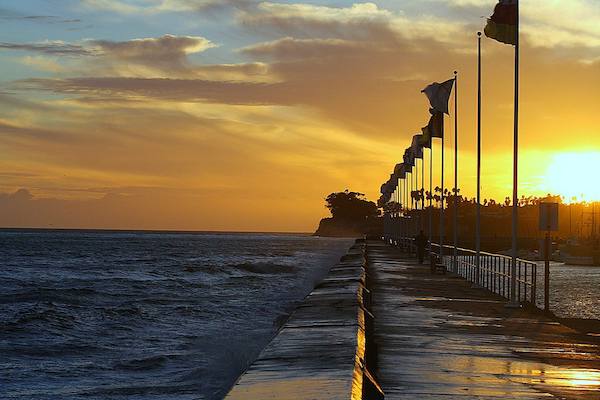
[Image above] Credit: Julian805; Flickr CC BY-ND-ND 2.0
Concrete is hardening America’s shores.
A new analysis—the first-ever look at America’s artificial coastal infrastructure—shows that 14% of U.S. shorelines have been artificially hardened. The research was recently presented at the annual meeting of the Ecological Society of America.
The analysis of NOAA data shows that 22,842 km (14,193 mi) of U.S. shoreline (which includes ocean, estuary, bay, and tidal river shores) is artificially hardened by concrete structures, including seawalls and bulkheads (which are akin to coastal retaining walls).
While that much concrete may be great for the industry, it’s not so good for the environment and for coastal communities, the research suggests.
Concrete structures are built to protect coastal communities from storms and sea level rise, but the research indicates the structures do the opposite—they often cause more damage instead.
The study shows that 66% of the hardened shores are concentrated along the southern Atlantic and Gulf coasts, areas that have a high proportion of grassy marshland shores. That’s bad news for the rich ecosystems that normally call those areas home, as concrete disrupts the natural habitats.
Credit: Ian Roberts; Flickr CC BY-SA 2.0
“If current trends continue, the researchers…project that up to one-third of the nation’s coastline could be hardened by 2100,” according to a Science news article about the research.
The concrete is not just harming ecosystems, though. The article continues, “But such trends are troubling, the scientists say, because hard structures not only protect shorelines (and the property values that go with them), but they also bounce waves’ energy seaward, where the water can scour beaches and destroy tidal marshes that are not protected by concrete, ultimately making coastal areas more vulnerable to storms.”
An alternative to concrete is natural or living shorelines, which use strategies including planted vegetation and offshore breakwaters or sills (elevated parts of the ocean floor that restrict water movement), to protect shores and preserve natural habitats simultaneously.
Examining coasts during Hurricane Irene, the authors found that sills and marshes better protected shores from erosion than did concrete bulkheads. “Our results suggest that living shorelines may sustain fish habitat and reduce erosion better than traditional hardening,” the study’s authors conclude.
And the coastal hardening is not just an American phenomenon—coasts worldwide have been shored up with concrete in marine urbanization projects of varying degrees and forms.
In Japan, concrete tetrapods—four-legged jack structures—are stacked up to steady the island country’s limited coastal land.
Many other countries build their own artificial structures for looks, development, or coastal loss mitigation strategies.
These interactive images of rising concrete infrastructure along Mediterranean coastlines demonstrate how much this area alone has changed over time. And rapidly developing areas like Dubai are taking on ambitious engineering projects that make extensive use of coastal real estate.
Dubai’s extensive coastal development. Credit: NASA Earth Observatory
“These artificial structures present a range of ecological problems, including loss of native species diversity and the spread of introduced species. Furthermore, the defenses to coastal shores that these structures, such as groynes and seawalls, are meant to provide could actually be causing more bad than good,” according to an article published on The Conversation.
The article, written by marine ecology researchers at the University of New South Wales, suggests that the research isn’t all doom and gloom, however. It’s a chance to learn and adapt our strategies going forward.
The UNSW authors agree with those who presented at the Ecological Society of America—engineering solutions that build on ecological principles, rather than going against them, could be the answer.
“Similarly, we can build seawalls and breakwaters in ways that not only help to protect the local area but are also designed to avoid environmental impacts. Why not transfer the urban concept of ‘green roofs’ to the sea, by seeding artificial structures with key desired and/or threatened species. Breakwaters in the Adriatic Sea have been successfully ‘seeded’ with the seaweed Cystoseira barbata and oyster reef restoration efforts can be applied to new foreshore developments. Seeding of key species can also improve water quality through the absorption or removal of contaminants.”


